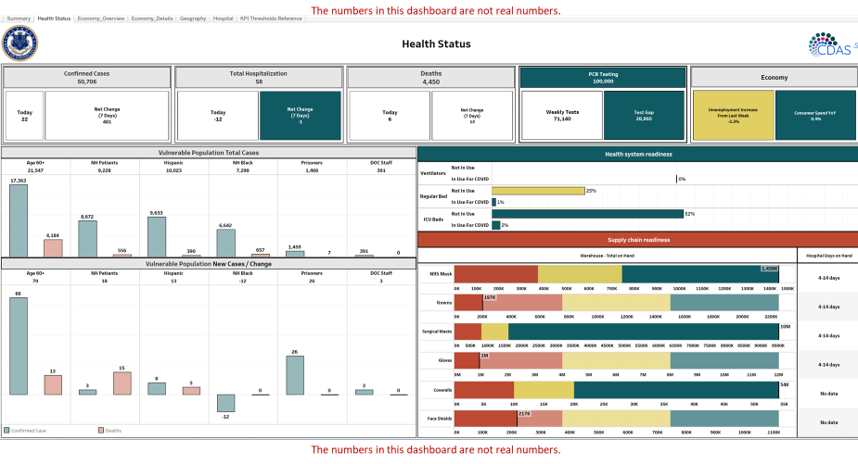Alan Fontes is an architect, but he doesn’t design houses.
Or skyscrapers. Or office buildings.
He designs solutions.
“I’ve been a solutions architect for over 20 years,” he says, “building data analytics and information management solutions around what we used to call ‘data warehouses,’ and designing the technologies that turn data into information and insight that we can deliver to users to make information-based decisions.”
Developing innovative information solutions is the bread-and-butter of the group Fontes established and leads – the UConn School of Nursing, Analytics and Information Management Solutions, or AIMS – and the technologies that Fontes and his team are currently building are not only helping to change how health information is accessed and used, they’re also part of the phased effort to reopen government and business operations in the state of Connecticut during the COVID-19 pandemic.
“The goal of AIMS has been to leverage the power and value of data and make it accessible to those who need it, and then use that accessible data to make decisions about how to effectively and efficiently provide services,” says School of Nursing Dean Deborah Chyun. “While our focus up until this year has been primarily on health information, the tools that AIMS has developed have practical applications that go far beyond health care, as is clearly the case with CDAS and Reopen Connecticut.”
CDAS – the Core Data Analytic Solution – is an advanced technological solution designed and developed by AIMS for the Connecticut Office of Health Strategy (OHS), as a component of the state’s Health Information Exchange (HIE).
“This is the most advanced innovative solution that I’ve architected,” says Fontes. “We leverage leading advances in technology systems and tools, and push the innovation envelope on how they can be used.”
“CDAS is critical to health care analytics across Connecticut. It is unique, valuable and inextricable to this agency’s work to evaluate the performance of Connecticut’s health care system, and develop better health care delivery and payment options,” says OHS Executive Director Victoria Veltri. “OHS is proud of its partnership with UConn AIMS on CDAS, and I’m personally glad to see its innovative architecture is being deployed here. I am relying on information from the UConn AIMS and the CDAS architecture for work on everything from health care affordability to the health information exchange to social determinant analyses. There are any number of possibilities; the homegrown nature of CDAS is just the beginning of the success to be celebrated.”
Fontes says: “CDAS is built for rapid response and rapid deployment to meet the needs of stakeholders within Connecticut. It can pull in health care data – from health care insurance claims to clinical data from electronic health or medical records through Connie, the state’s HIE. CDAS organizes this data – and builds out analytics to help decision-makers understand what’s going on and the outcomes, so that they can decide how to set policies or establish and manage programs. It’s all centered on quality and improvement in health delivery and services.”
While CDAS helps fill Connecticut’s health needs, that’s not nearly all it can do.
For the state’s COVID-19 reopening effort, that necessary data crosses multiple departments and both public and private stakeholders are captured, such as COVID tests, hospitals’ COVID patient counts, and data relating to utilization, unemployment, public health, correction and education.
Fontes and his team, though, were up for the important challenge of not only providing the analytics solution, but for turning around accessible dashboards for the Governor’s Reopen CT team within a few weeks.
“Within a day, the team was able to configure and open a CDAS environment,” Fontes says. “Within a couple of weeks, they had automated the intake of data files from data sources, such as the state’s Open Data Portal, and process them as they arrived to get the most current information out.”
“As the state prepared for reopening, the state wanted to make sure that senior leadership had an eye on key metrics that could be pulled together and viewed on a single platform,” said Scott Gaul, Connecticut’s Chief Data Officer. “We reached out to Alan at UConn AIMS, anticipating that we needed something that would be sufficient to handle the long-term impact and expansion of the data and the need for rapid real-time information. With UConn AIMS and CDAS, we now have this capability within the state, as it enabled us to pull in different data sources and turn that around faster with a wider range of tools and more improved security.”
Mark Raymond, the state’s Chief Information Officer, has a bird’s-eye view of state technology, and says, “In this instance, combining aggregate data from multiple sources where decision making falls outside one individual agency allowed the state to make a better decision on where we are. UConn AIMS moved with swiftness and demonstrated how CDAS could be utilized. What is impressive that they were able to pull this together in such a short period of time.”
Since standing up the system in early May, Fontes and his project team – which includes three AIMS staff members in addition to Fontes – have continued to refine the functions and the user interface while working with agencies and stakeholders to further automate data intake.
“Working with the CDAS team was a great way of enabling us to do more than what we are currently equipped to do,” Gaul says. “The CDAS team has really stepped in and pulled that data from a variety of different sources quickly, deftly, and managed to keep it safe and secure.”
While its speedy implementation came at a time of immediate and critical need, the application of CDAS to broader state government functions provides a tool that could potentially be expanded and utilized long after the coronavirus threat has subsided – helping to bring agency data together across the state and providing policymakers and other stakeholders with analytics to aid in making information-based decisions.



